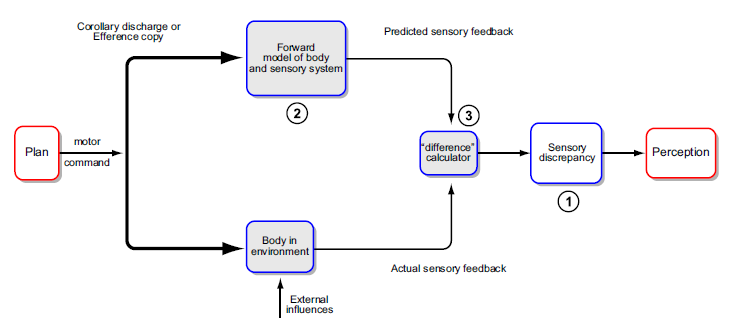Student: Your post for October 15th, 2012 had the title, “What is meant by Effort or Exertion?” Have you gotten any clues?
Professor: Well, as a matter of fact I reread that Post, and I found a review article by Prostke and Gandevia (2012) that have provided some much needed insight.
Here is some of what I wrote back in 2012:
“… While jogging on the level at a slow pace for me, I was doing more thoughts about “Where is the next patch of thick grass for my sore feet?” than “Push on each stride.” “What is my Rating of Perceived Exertion” was not anywhere in my self-talk. Coming to an upslope, however, to maintain my pace, at first I did have to focus a bit on “Push a little more with each stride”. Then once I noticed I was pushing “hard enough”, my self-talk shifted to focus upon running relaxed, and I comfortably crossed over the little hill.” [Emphases added]
Professor: Notice that effort for me was not conscious until I had to focus on my running. My research on effort had biased my ‘noticing’ to look for only a “motor command”.
Part way through their very informative review for an old-timer like me they wrote a subsection on “the Sense of Effort” which went like this:
“…the view during much of the 19th century was that our muscle senses arose entirely centrally, and this included the sense of effort experienced during execution of a motor task. However, during the middle of last century, two influential reports argued for a combined central-peripheral mechanism for proprioception. The impact of these ideas is still evident today.
- In a study of eye movements in fish, Sperry (369) introduced the term corollary discharge meaning, “a corollary discharge of motor patterns into the sensorium may play an important adjuster role … along with non-retinal and postural influences from the periphery”. So here was the suggestion of a central sensory area acted upon by both motor command signals as well as signals originating in the periphery.
- In the same year, 1950, von Holst and Mittelstaedt (393) put forward a similar proposition based on experiments in insects. They introduced one additional important concept that continues to be influential. They distinguished between afferent signals generated by the animal’s own actions and signals generated by external sources as the animal moved about in its environment. The term exafference was used for afferent signals generated by stimuli of an external origin and the term reafference was used for afferent activity arising from the body’s own actions. The reafference was calculated using an efference copy of the motor command. [Emphases added]
“It remains a matter of conjecture whether the efference copy is an accurate copy of the motor outflow, or a computation, based on past experience, of the expected afferent signal for a given motor outflow (95). The total afferent signal generated during a motor act is made up of two components: the predicted reafferent signal, determined by the motor command, and afferent activity generated independently of the motor command, as a result of external influences. While the corollary discharge hypothesis was put forward to deal with the problem of visual stability during eye movements, the efference copy hypothesis has implications for all movements (194). These ideas have recently been formalized in a model for motor control (19, 423). Some aspects of such a model are considered in FIGURE 11.
FIGURE 11. Model for a central comparison between sensory and motor signals, based on the proposal of Bays and Wolpert (19). The process begins with the intention to move (Plan), leading to generation of a motor command and its efference copy/corollary discharge. The Forward model uses the efference copy to calculate the expected outcome, and this is compared with the input (Body in Environment) by means of a difference calculator to quantify the sensory discrepancy that determines what is actually perceived (Perception). Three points for consideration are as follows: 1) if the predicted and actual sensory feedback match, the anomalous situation arises where there is no perception at all; 2) the forward model needs to be regularly updated over both short and long time scales; and 3) the “difference calculator” is more complicated than depicted here because, at least for force sensation, its output is not determined by a simple subtraction process (for details, see Ref. 402).
“The underlying idea is that not all of the signals generated by a movement reach consciousness, and we perceive only the exafferent component. So, for example, the sensation when we are tickled by someone else differs in quality and is much more intense than when we attempt to tickle ourselves (23, 24). Part of the mystery of the proprioceptive senses is that much of the afferent information generated by self-initiated movements does not reach consciousness. As a consequence, the detection and perceived intensity of afferent signals are diminished during movement (for references, see Refs. 260, 414). Such suppression can occur along somatosensory pathways (e.g., Ref. 67) as well as from the actions of the motor command signals themselves (415).”
Student: What do they mean by, “we perceive only the exafferent component”?
Professor: We are out of time today. Hold onto that question and please read their review, especially the parts about force and effort percepts including Figure 16. Let’s discuss the rest of their review next week.
Reference
Proske U, Gandevia SC. (2012) The proprioceptive senses: their roles in signaling body shape, body position and movement, and muscle force. Physiol Rev 92: 1651–1697.
